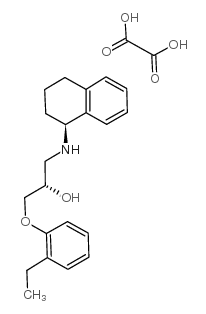174689-39-5
| Name | SR 59230A hydrochloride,1-(2-Ethylphenoxy)-3-[[(1S)-1,2,3,4-tetrahydro-1-naphthalenyl]amino]-(2S)-2-propanolhydrochloride |
|---|---|
| Synonyms | 3-(2-Ethylphenoxy)-1-[[(1S)-1,2,3,4-tetrahydronaphth-1-yl]amino]-(2S)-2-propanol oxalate salt |
| Description | SR59230A is a potent, selective, and blood-brain barrier penetrating β3-adrenergic receptor antagonist[1] with IC50s of 40, 408, and 648 nM for β3, β1, and β2 receptors, respectively[2]. |
|---|---|
| Related Catalog | |
| Target |
IC50: 40 nM (β3 receptor), 408 nM ((β1 receptor), 648 nM (β2 receptor)[2] |
| In Vitro | SR59230A (100 nM-50 μM; 24 hours) is able to reduce cell viability in a dose-dependent manner in Neuro-2A, BE(2)C and SK-N-BE(2) NB cell lines[3]. Cell Viability Assay[3] Cell Line: Three different neuroblastoma (NB) cell lines, one murine (Neuro-2A) and two human (SK-N-BE(2), BE(2)C) Concentration: 100 nM, 1 μM, 5 μM, 10 μM, and 50 μM Incubation Time: 24 hours Result: Reduced cell viability in a dose-dependent manner, with significant effect at a concentration limit over 1 µM for Neuro-2A cells and 5 µM for SK-N-BE(2) and BE(2)C). |
| In Vivo | MDMA (20 mg/kg) produces a slowly developing hyperthermia, reaching a maximum increase of 1.8°C at 130 min post injection. SR59230A (0.5 mg/kg) produces a small but significant attenuation of the slowly developing hyperthermia to MDMA. SR59230A (5 mg/kg) reveals a significant and marked early hypothermic reaction to MDMA[4]. Animal Model: Male C-57BL6J wild-type mice (22-35 g)[4] Dosage: 0.5 or 5 mg/kg Administration: Injected s.c.; administered 30 min prior to the injection s.c. of MDMA (20 mg/kg). Result: Modulated the actions of MDMA on temperature involve α1-adrenoceptor antagonism. |
| References |
| Boiling Point | 542.6ºC at 760mmHg |
|---|---|
| Molecular Formula | C23H29NO6 |
| Molecular Weight | 415.47900 |
| Flash Point | 281.9ºC |
| Exact Mass | 415.19900 |
| PSA | 116.09000 |
| LogP | 3.20240 |
| Vapour Pressure | 1.27E-11mmHg at 25°C |
| Personal Protective Equipment | Eyeshields;Gloves;type N95 (US);type P1 (EN143) respirator filter |
|---|---|
| Risk Phrases | 22-24/25 |
| RIDADR | NONH for all modes of transport |
